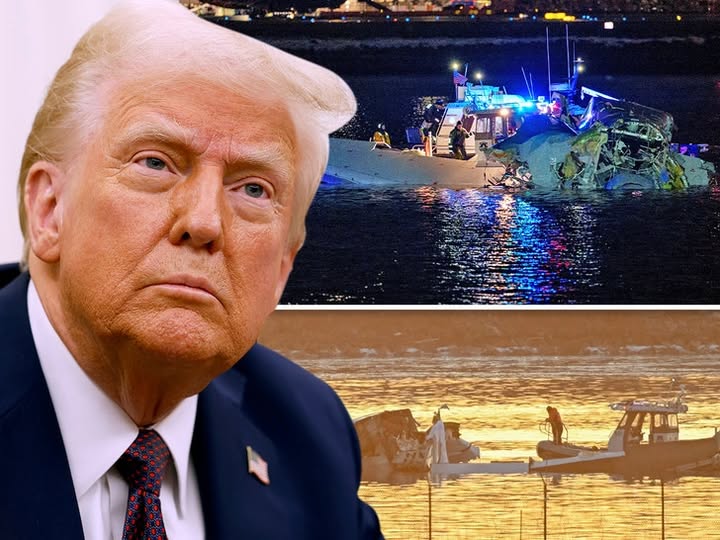
“A Tragedy of Terrible Proportions”—Trump Reacts to Deadly Mid-Air Collision Over D.C.
The chaos in Washington, D.C., began on the evening of January 29, when a routine American Airlines flight turned into a catastrophic disaster. As AA Flight 5342 approached Ronald Reagan Washington National Airport, it collided mid-air with a U.S. Army Black Hawk helicopter over the Potomac River.
The impact was devastating. The passenger jet, carrying 64 people, was torn apart by the collision, while all three soldiers aboard the helicopter were killed instantly. The crash is now believed to be the deadliest air disaster in over two decades.
The following morning, President Donald Trump, 78, addressed the nation in an urgent press briefing, calling the incident “a tragedy of terrible proportions.” But his remarks quickly took a controversial turn, as he blamed the disaster on government diversity, equity, and inclusion (DEI) policies and the mental health of aviation employees.
Trump Clashes With Reporters Over Blame
As the press conference unfolded, tensions between Trump and the media escalated.
CNN’s Kaitlan Collins confronted the president, challenging his decision to immediately link the crash to political policies.
“We don’t even know the names of the 67 people who were killed, and you are already blaming Democrats, DEI, air traffic control, and even the U.S. military pilot in the Black Hawk helicopter,” Collins stated before asking, “Don’t you think you’re getting ahead of the investigation?”
Trump scoffed at the question. “No, I don’t think so at all. Are you asking about the names of the passengers? Do you think that matters right now? That’s not a very intelligent question. I’m shocked you said that.”
Another reporter pressed him further, questioning whether it was appropriate to blame DEI hiring initiatives, air traffic controllers, or even the military pilots before the investigation had concluded.
Trump, visibly frustrated, snapped back, “I have common sense.”
He went on to claim that the nation’s air traffic control system was outdated and poorly managed. “The system wasn’t built correctly. I was going to rebuild it, and then we had an election that came out differently than expected. They spent far more money renovating an old system instead of investing in a completely new, state-of-the-art air traffic control network.”
Then he added, “Air traffic controllers need to be at the highest level of genius.”
Trump Targets FAA Diversity Policies
The president then pivoted to criticizing the Federal Aviation Administration (FAA), specifically its hiring policies.
“FAA’s diversity push includes hiring people with severe intellectual and psychiatric disabilities,” Trump stated. “And they say these individuals are the most underrepresented in the workforce. That’s fine, but they want them working as air traffic controllers. I don’t think that’s a good idea.”
He doubled down, claiming the FAA’s policies—initiated under previous administrations—prioritized diversity over competency and put lives at risk.
“They are actively recruiting workers who suffer from severe intellectual disabilities, psychiatric problems, and other mental and physical conditions. You need a very special talent and a very special genius to do that job. I don’t believe this approach guarantees safe and effective travel.”
Fact-Checking the Claims
NBC News’ Peter Alexander challenged Trump’s statements, pointing out that the FAA’s diversity hiring policy had existed long before the Biden administration—in fact, since 2013.
“This policy was in place during your entire presidency, too. If it’s such a problem, why didn’t you change it during your first term?” Alexander asked.
Trump dismissed the question. “I did change it. Biden reversed it. You should look into that.”
When Alexander pushed back again, Trump brushed him off. “That’s totally irrelevant and not a very good question.”
What We Know About the Crash So Far
Authorities are still piecing together the final moments before impact.
The American Airlines flight was on a standard approach to Washington National Airport, while the Black Hawk helicopter was performing an annual proficiency training flight.
According to preliminary reports, the control tower had asked the Black Hawk crew if they had the passenger jet in sight. The response suggested they did—but moments later, the two aircraft collided.
The passenger plane split in half on impact, plummeting into the Potomac River, while the military helicopter was obliterated.
Aviation experts have emphasized the importance of the Traffic Alert and Collision Avoidance System (TCAS), which is designed to prevent mid-air collisions. Investigators are now probing whether a failure in this system—or human error—played a role in the tragedy.
Kansas Senator Jerry Moran, whose state lost several residents in the crash, expressed his deep sorrow, confirming that no one survived.
What Comes Next?
The National Transportation Safety Board (NTSB) and the Federal Aviation Administration (FAA) have launched a full-scale investigation into the disaster.
As families mourn the victims, the political battle over air traffic safety, hiring policies, and government accountability is only just beginning.

